
University of Sydney and Japan’s National Institute of Materials Science (NIMS) scientists have just discovered that artificial networks of nanowires can be trained to react like a brain when electrically stimulated, thus opening pathways to artificial intelligence research. By maintaining the nanowire network in a brain-like state at the “edge of chaos,” tasks can be performed at the optimal level.
This finding suggests that the underlying properties of neurointelligence are physical, thus paving the way for the development of artificial intelligence. During the study, if the signal stimulating the network was deemed too low, the path was then deemed too predictable and orderly. However, when the electrical signal overwhelmed the network, the output was completely chaotic and did not help solve the problem. So, the optimum signal to produce useful output was at the “Edge of Chaos”.
- 10th Generation Intel Core i7-10750H 6-Core Processor (Up to 5.0GHz)
- Overclockable NVIDIA GeForce RTX 3060 Laptop GPU with 6 GB of dedicated GDDR6 VRAM, NVIDIA DLSS, NVIDIA Dynamic Boost 2.0, NVIDIA GPU Boost
- 15.6" Full HD (1920 x 1080) Widescreen LED-backlit IPS Display (144Hz Refresh Rate, 3ms Overdrive Response Time & 300nit Brightness)
We used wires 10 micrometers long and 500 nanometers or less in thickness randomly placed on a two-dimensional plane. Where the wires overlap, they form electrochemical junctions, like synapses between neurons. It turns out that electrical signals sent over this network automatically find the best route to send information,” said Joel Hochstetter, the lead author, a PhD candidate at the University of Sydney’s Nanolabs and Department of Physics.





